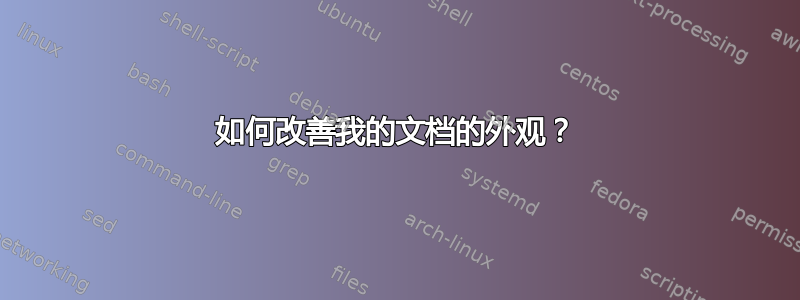
介绍
我从理论计算机科学讲座中输入了一些定义,只是为了好玩。不幸的是,我注意到它看起来不太专业和干净。原因应该是错误的对齐等,但我无法真正改进它,即使我尝试定义定理/定义环境和类似的东西。不幸的是,我的定义看起来仍然很糟糕。
问题
如何改善我的文档的外观?
我希望获得一些建议(关于包、环境、间距、分段等),这将有助于我改进我的文档。
编辑:我希望我所做的每个定义都有真实的定义环境,以便对其进行标记。此外,一些方程式对齐不良(例如“形式语言”的最后一个方程式)。此外,我希望获得一些建议,关于如何使文档看起来更现代(例如通过添加颜色和更改字体)
代码
注意:该文件翻译得不好,因为英语不是我的母语。我只翻译了文档(从德语到英语),以便您理解内容并能根据内容帮助格式化。该文件基本上是 TCS 讲座中的一小段定义列表。
这是我的代码:
\documentclass{memoir}
\usepackage[utf8]{inputenc}
\usepackage{amsmath}
\title{Computer-Science (Poor translation)}
\author{Doesbaddel}
\date{November 2018}
\begin{document}
\maketitle
\begin{abstract}
Note: The file is translated poorly, because English is not my native language. I only translated the document (from german to english), in order that you understand the content and can help with formatting based on it. The file is basically a small list of definitions from the TCS lecture.
\end{abstract}
\section{Fundamentals}
Definition:
\begin{enumerate}
\item {\em Finite Alphabet:} Finite set $\Sigma := \{a_1,\dots , a_\Delta\}$ with various objects\\ $a_1, \dots , a_\Delta$
\item A {\em word/string} $w=(w_1,\dots , w_n)$ with $w_i\in \Sigma$ for $1\leq i \leq n$ is called a concatenation of letters in $\Sigma$.\\
\emph{The length of} $w$ \emph{is} ${\mid w \mid} := n$\\
Strings with the length of $n$: $\Sigma^n = \underbrace{\Sigma \times \Sigma \dots \times \Sigma}_{n}$\\
The empty string is $\lambda$: ${\mid \lambda \mid} := 0$\\
$\Sigma^* := \bigcup^{\infty}_{n=0} \Sigma^n \text{ is the set of all strings with finite length on } \Sigma.$\\
$\Sigma^* := \{\lambda\}\text{ is not the empty set, because }\lambda\in\Sigma^*$\\
$\Sigma^+ := \Sigma^*\backslash \{\lambda\}$
\item Let $X=(x_1,\dots ,x_n)$, $Y=(y_1,\dots ,y_n)$ then
\[X.Y:=(x_1,\dots ,x_n,y_1,\dots ,y_m)\] is called the concatenation of $x$ and $y$. $X$ is called the prefix of $XY$; $Y$ is called the Suffix.\\
Obvious:
\begin{align*}
\mid x.y\mid &= \mid x\mid +\mid y\mid\\
\mid x.\lambda \mid &= \mid \lambda .x\mid = \mid x\mid
\end{align*}
Notation: $x.y = xy = x_1x_2\dots x_ny_1y_2\dots y_n$
\item Any $L\subseteq \Sigma^*$ is called a "formal language" on $\Sigma$.
\end{enumerate}
Definition: Let $\Sigma$ be a finite alphabet, $L_0,L_1,L_2 \subseteq \Sigma^*$ (free formal languages in the finite alphabet.)
\begin{enumerate}
\item $\overline{L} := \Sigma^*\backslash L \text{ compliment of } L$
\item $L_1 \cap L_2 := \{ x \in \Sigma^* \mid x \in L_1 \land x \in L_2 \} \text{ Intersection}$\\
$L_1 \cup L_2 := \{ x \in \Sigma^* \mid x \in L_1 \lor x \in L_2 \} \text{ Union}$
\item $L_1.L_2 := \{ xy \mid x \in L_1 \land y \in L_2 \} \text{ Concatenation of two languages}$
\item $L^* := \{ w_1 w_2 \dots w_t \mid w_i \in L \lor w_i = \lambda \land t \in N \} \} \text{ Kleene-Star of }L$\\
\emph{Please note:} $\lambda \in L^*$ with $t = 1$, $w_1 = \lambda$\\
$L^+ = L.L^*$\\
$\lambda \in L^+ \Longleftrightarrow \lambda \in L$
\end{enumerate}
\section{Regular Expressions}
Idea: Recursive construction of expressions, which represent the languages.
Definition: Let $\Sigma$ be a finite alphabet. The set of regular expressions on $\Sigma$ and their represented languages are defined in the following way:
\begin{enumerate}
\item $\emptyset$,$\lambda$ and any $a \in \Sigma$ are regular expressions\\
The related languages are:
\begin{align*}
\mathcal{L}(\emptyset) &:= \emptyset\\
\mathcal{L}(\lambda) &:= \lambda\\
\mathcal{L}(a) &:=\{a\} \qquad \forall a \in \Sigma
\end{align*}
\item Let $x,y$ be regular expressions with related languages $\mathcal{L}(x)$, $\mathcal{L}(y)$.
Hence, the following expressions are regular too:
\begin{align*}
& x.y \text{ and } \mathcal{L}(x.y):= \mathcal{L}(x).\mathcal{L}(y)\\
& x\cup y \text{ and } \mathcal{L}(x\cup y):= \mathcal{L}(x)\cup \mathcal{L}(y)\\
& x^* \text{ and } \mathcal{L}(x^*):= \mathcal({L}(x))^*
\end{align*}
\item Everything that can be produced with \em{1.} and \em{2} in finite steps is regular.
\end{enumerate}
The related languages are called regular languages.
\section{Automata}
Definition: The deterministic, finite automaton \emph{(DFA)} $M$ is defined as \[M=(K,\Sigma,s,\delta ,F)\] with:
\begin{itemize}
\item $K = K \times \Sigma$ finite set of states
\item $\Sigma$ finite alphabet
\item $s$ initial state
\item $\delta$ transition function
\item $F$ finite set of final states
\end{itemize}
\end{document}
问候,
杜斯巴德尔


